One-Legged Torii

|
One-Legged Torii, Nagasaki
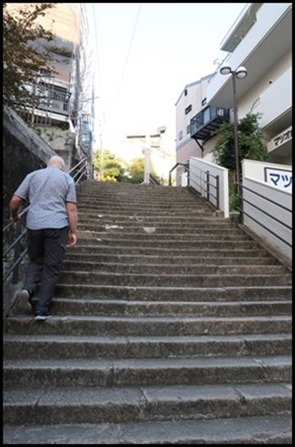   Our last excursion of the day was to
walk from the Cathedral to the One-Legged Torii. Bear
went to the top so I could take the pictures. I’ll take pictures of the broken
off bit on my phone if you like. It seemed tardy to me not to go up, so pleased
I did.
Fuller description of Torii below All in All, but
basically a torii is a traditional Japanese gate
most commonly found at the entrance of or within a Shinto
shrine, where it symbolically marks the transition from
the profane to sacred.
  The broken
pieces.
The plaque reads: Atomic Bomb-Damaged Torii Arch at
Sanno Shinto Shrine. This arch was built in October 1924 as the second torii
arch at Sanno Shinto Shrine. The explosion of the atomic bomb at 11:02 a.m.,
August 9, 1945 slapped down one of the pillars. Located only 800 metres
southeast of the hypocentre, the upper parts of the arches were scorched black
by the fierce radiating heat, one of the crossbeam shifted in the opposite
direction as a result of the blast
pressure.
An explosion of a single atomic bomb reduced the
surrounding neighbourhood to ashes and rubble, but this arch endured the blast
and continues to this day to stand on only one pillar as though
testifying to the atomic devastation. The base of the pillar and its adjoining
parts have been reinforced to ensure
safety.
Nagasaki City installs this plaque as a prayer for
the repose of the souls of the people who died here and to ensure that this
tragedy is never repeated.
  We walked further on for a picture
facing the other way, from here we could see a road
marker with an information board.
 Urakami Road Monument: Urakami
Road was the main road in Nagasaki until the middle of the Edo Period
when it was surpassed by the Nagasaki Road that traversed the Himi Mountain
Pass. Many people travelled on this road including the 26 Saints of Japan and
Dutch East India Company Doctor Kaempfer.
The course spanned a distance of forty kilometres
split into two main paths: the twelve kilometre distance from present day
Nishizaka Park (Nishizaka-machi) through Urakami and up to Nishisonogi-gun
Togitsu-cho and the twenty eight kilometre distance by boat through Omura Bay
from Togitsu-cho to Higashi Sonogi-gun Higashi
Sonogi-cho.
 Just to the right of the road marker was this happy totem pole.
 Away to our left was a pair of
handsome lions guarding some steps, we went to investigate.
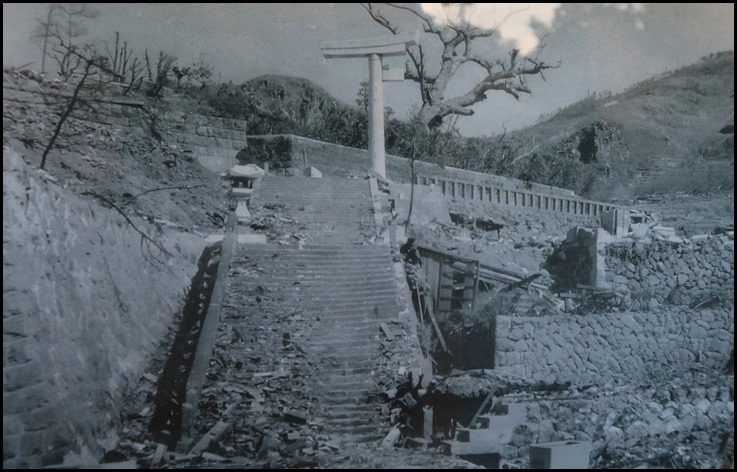 The two huge
camphor trees at top of the steps ended up getting their own blog. Further along
the path was a cabinet with some remarkable pictures, this is one of them –
the torii after the bomb.
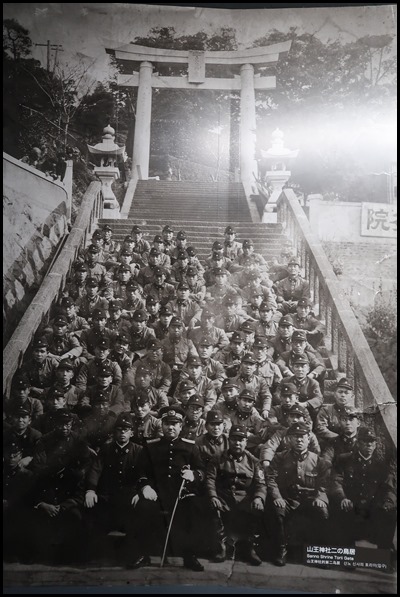  We saw this
picture during our visit to the A Bomb Museum. Soldiers by
the torii and Bear today.
 We retrace our
steps passing the plinths where the lanterns used to
stand.
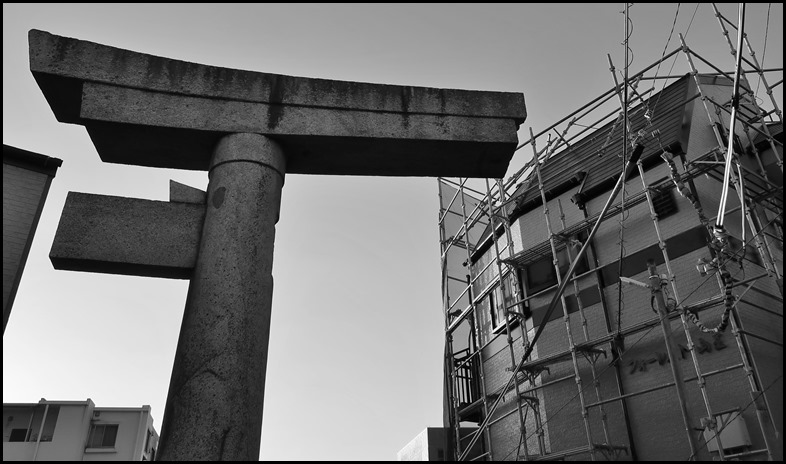 ALL IN ALL A WONDERFUL SYMBOL
OF DEFIANCE
QUITE
EXTRAORDINARY
A torii (鳥居, literally bird abode) is a traditional Japanese gate most commonly found at the entrance of or within a Shinto shrine, where it symbolically marks the transition from the profane to the sacred. The presence of a torii at the entrance is usually the simplest way to identify Shinto shrines, and a small torii icon represents them on Japanese road maps. They are however a common sight at Japanese Buddhist temples too, where they stand at the entrance of the temple’s own shrine, called chinjusha (鎮守社, tutelary god shrine) and are usually very small. Their first appearance in Japan can be reliably pinpointed to at least the mid-Heian period because they are mentioned in a text written in 922. The oldest existing stone torii was built in the 12th century and belongs to a Hachiman Shrine in Yamagata prefecture. The oldest wooden torii is a ryōbu torii at Kubō Hachiman Shrine in Yamanashi prefecture built in 1535. Torii were traditionally made from wood or stone, but today they can be also made of reinforced concrete, copper, stainless steel or other materials. They are usually either unpainted or painted vermilion with a black upper lintel. Inari shrines typically have many torii because those who have been successful in business often donate in gratitude a torii to Inari, kami of fertility and industry. Fushimi Inari-taisha in Kyoto has thousands of such torii, each bearing the donor’s name. The Japanese torii is derived from the Indian Torana which also inspired the Chinese Paifang. The function of a torii is to mark the entrance to a sacred space. For this reason, the road leading to a Shinto shrine (sandō) is almost always straddled by one or more torii, which are therefore the easiest way to distinguish a shrine from a Buddhist temple. If the sandō passes under multiple torii, the outer of them is called ichi no torii (一の鳥居, first torii). The following ones, closer to the shrine, are usually called, in order, ni no torii (二の鳥居, second torii) and san no torii (三の鳥居, third torii). Other torii can be found farther into the shrine to represent increasing levels of holiness as one nears the inner sanctuary (honden), core of the shrine. Also, because of the strong relationship between Shinto shrines and the Japanese Imperial family, a torii stands also in front of the tombs of each Emperor. Whether torii existed in Japan before Buddhism or, to the contrary, arrived with it is, however, an open question. In the past torii must have been used also at the entrance of Buddhist temples. Even today, as prominent a temple as Osaka’s Shitennō-ji, founded in 593 by Shōtoku Taishi and the oldest state-built Buddhist temple in the world (and country), has a torii straddling one of its entrances. (The original wooden torii burned in 1294 and was then replaced by one in stone.) Many Buddhist temples include one or more Shinto shrines dedicated to their tutelary kami (“Chinjusha”), and in that case a torii marks the shrine’s entrance. Benzaiten is a syncretic goddess derived from the Indian divinity Sarasvati which unites elements of both Shinto and Buddhism. For this reason, halls dedicated to her can be found at both temples and shrines, and in either case in front of the hall stands a torii. The goddess herself is sometimes portrayed with a torii on her head. Finally, until the Meiji period (1868 -1912) torii were routinely adorned with plaques carrying Buddhist sutras. The association between Japanese Buddhism and the torii is therefore old and profound. Yamabushi, Japanese mountain ascetic hermits with a long tradition as mighty warriors endowed with supernatural powers, sometimes use as their symbol a torii. The torii is also sometimes used as a symbol of Japan in non-religious contexts. For example, it is the symbol of the Marine Corps Security Force Regiment and the 187th Infantry Regiment, 101st Airborne Division and of other US forces in Japan.   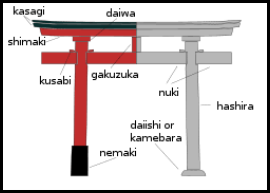 Torii can come in a variety of arched
shapes, be huge or small but always made up of named parts.
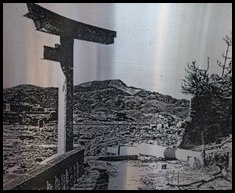 But there is only
one one-legged Torii and we are so pleased to
have visited it.
|